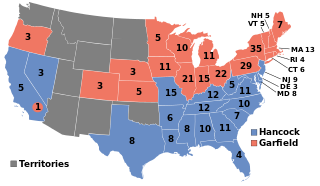
The 1880 United States presidential election was the 24th quadrennial presidential election, held on Tuesday, November 2, 1880, in which Republican nominee James A. Garfield defeated Winfield Scott Hancock of the Democratic Party. The voter turnout rate was one of the highest in the nation's history. Garfield was assassinated during his first year in office, and he was succeeded by his vice president, Chester A. Arthur.
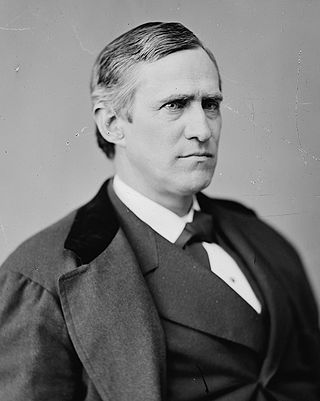
Thomas Francis Bayard was an American lawyer, politician and diplomat from Wilmington, Delaware. A Democrat, he served three terms as the United States Senator from Delaware and made three unsuccessful bids for the Democratic nomination for President of the United States. In 1885, President Grover Cleveland appointed him Secretary of State. After four years in private life, he returned to the diplomatic arena as Ambassador to Great Britain.

The National Banking Acts of 1863 and 1864 were two United States federal banking acts that established a system of national banks, and created the United States National Banking System. They encouraged development of a national currency backed by bank holdings of U.S. Treasury securities and established the Office of the Comptroller of the Currency as part of the United States Department of the Treasury and a system of nationally chartered banks. The Act shaped today's national banking system and its support of a uniform U.S. banking policy.
The Specie Payment Resumption Act of January 14, 1875 was a law in the United States that restored the nation to the gold standard through the redemption of previously unbacked United States Notes and reversed inflationary government policies promoted directly after the American Civil War. The decision further contracted the nation's money supply and was seen by critics as an exacerbating factor of the so-called Long Depression, which struck in 1873.
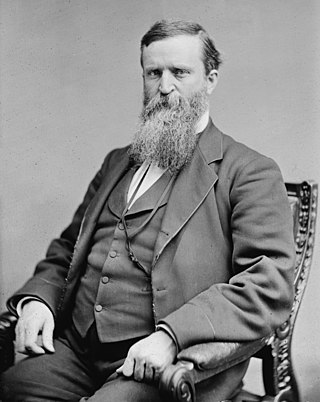
James Baird Weaver was an American politician in Iowa who was a member of the United States House of Representatives and two-time candidate for President of the United States. After several unsuccessful attempts at Republican nominations to various offices, and growing dissatisfied with the conservative wing of the party, in 1877 Weaver switched to the Greenback Party, which supported increasing the money supply and regulating big business. As a Greenbacker with Democratic support, Weaver won election to the House in 1878. The Greenbackers nominated Weaver for president in 1880, but he received only 3.3 percent of the popular vote. After several more attempts at elected office, he was again elected to the House in 1884 and 1886. In Congress, he worked for expansion of the money supply and for the opening of Indian Territory to white settlement.
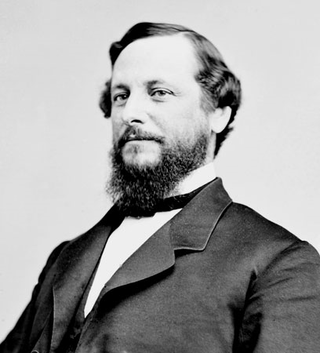
George Hunt Pendleton was an American politician and lawyer. He represented Ohio in both houses of Congress and was the unsuccessful Democratic nominee for Vice President of the United States in 1864.
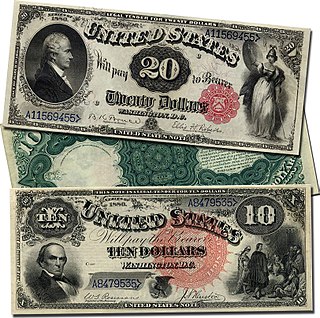
A United States Note, also known as a Legal Tender Note, is a type of paper money that was issued from 1862 to 1971 in the United States. Having been current for 109 years, they were issued for longer than any other form of U.S. paper money. They were known popularly as "greenbacks", a name inherited from the earlier greenbacks, the Demand Notes, that they replaced in 1862. Often termed Legal Tender Notes, they were named United States Notes by the First Legal Tender Act, which authorized them as a form of fiat currency. During the early 1860s the so-called second obligation on the reverse of the notes stated:
This Note is a Legal Tender for all debts public and private except Duties on Imports and Interest on the Public Debt; and is receivable in payment of all loans made to the United States.

Legal tender is a form of money that courts of law are required to recognize as satisfactory payment for any monetary debt. Each jurisdiction determines what is legal tender, but essentially it is anything which when offered ("tendered") in payment of a debt extinguishes the debt. There is no obligation on the creditor to accept the tendered payment, but the act of tendering the payment in legal tender discharges the debt.
The Greenback Party was an American political party with an anti-monopoly ideology which was active from 1874 to 1889. The party ran candidates in three presidential elections, in 1876, 1880 and 1884, before it faded away.
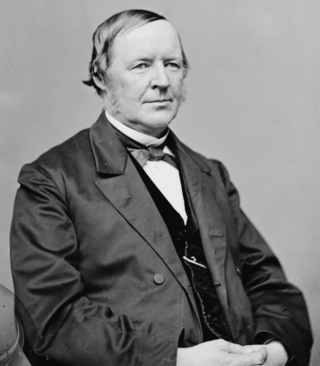
Hugh McCulloch was an American financier who played a central role in financing the American Civil War. He served two non-consecutive terms as U.S. Treasury Secretary under three presidents. He was originally opposed to the creation of a system of national banks, but his reputation as head of the Bank of Indiana 1857 to 1863 persuaded the Treasury to bring him in to supervise the new system as Comptroller of the Currency 1863–65. As Secretary of the Treasury 1865–69 he reduced and funded the gigantic Civil War debt of the union, and reestablished the federal taxation system across the former Confederate States of America. He tried but failed to make a rapid return to the gold standard.

Free silver was a major economic policy issue in the United States in the late 19th century. Its advocates were in favor of an expansionary monetary policy featuring the unlimited coinage of silver into money on-demand, as opposed to strict adherence to the more carefully fixed money supply implicit in the gold standard. Free silver became increasingly associated with populism, unions, and the struggle of ordinary Americans against the bankers, monopolists, and robber barons of the Gilded Age. Hence, it became known as the "People's Money".
The history of the United States dollar began with moves by the Founding Fathers of the United States of America to establish a national currency based on the Spanish silver dollar, which had been in use in the North American colonies of the Kingdom of Great Britain for over 100 years prior to the United States Declaration of Independence. The new Congress's Coinage Act of 1792 established the United States dollar as the country's standard unit of money, creating the United States Mint tasked with producing and circulating coinage. Initially defined under a bimetallic standard in terms of a fixed quantity of silver or gold, it formally adopted the gold standard in 1900, and finally eliminated all links to gold in 1971.

Greenbacks were emergency paper currency issued by the United States during the American Civil War that were printed in green on the back. They were in two forms: Demand Notes, issued in 1861–1862, and United States Notes, issued in 1862–1865. A form of fiat money, the notes were legal tender for most purposes and carried varying promises of eventual payment in coin but were not backed by existing gold or silver reserves.
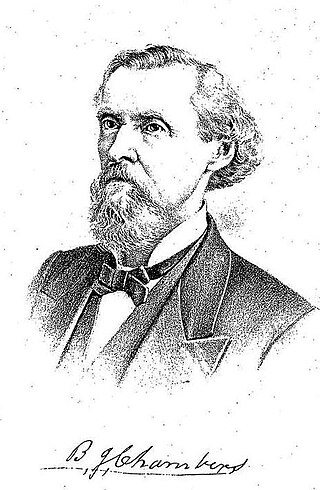
Barzillai Jefferson Chambers was an American surveyor, lawyer, and politician of the Gilded Age. Born in Kentucky, he moved to Texas to join its war for independence against Mexico. Chambers stayed in Texas after its independence and annexation by the United States, earning a living as a surveyor and farmer in Johnson County. In the American Civil War, he served briefly in the Confederate army, then returned to his farming and business interests, becoming part-owner of a bank in his hometown of Cleburne.

The Public Credit Act of 1869 in the USA states that bondholders who purchased bonds to help finance the Civil War would be paid back in gold. The act was signed on March 18, 1869, and was mainly supported by the Republican Party, notably Senator John Sherman.

A Treasury Note is a type of short term debt instrument issued by the United States prior to the creation of the Federal Reserve System in 1913. Without the alternatives offered by a federal paper money or a central bank, the U.S. government relied on these instruments for funding during periods of financial stress such as the War of 1812, the Panic of 1837, and the American Civil War. While the Treasury Notes, as issued, were neither legal tender nor representative money, some issues were used as money in lieu of an official federal paper money. However the motivation behind their issuance was always funding federal expenditures rather than the provision of a circulating medium. These notes typically were hand-signed, of large denomination, of large dimension, bore interest, were payable to the order of the owner, and matured in no more than three years – though some issues lacked one or more of these properties. Often they were receivable at face value by the government in payment of taxes and for purchases of publicly owned land, and thus "might to some extent be regarded as paper money." On many issues the interest rate was chosen to make interest calculations particularly easy, paying either 1, 1+1⁄2, or 2 cents per day on a $100 note.
Monetary policy in the United States is associated with interest rates and availability of credit.

John Sherman was an American politician from Ohio who served in federal office throughout the Civil War and into the late nineteenth century. He was the younger brother of Union general William Tecumseh Sherman, with whom he had a close relationship.

The 1880 Greenback Party National Convention convened in Chicago from June 9 to June 11 to select presidential and vice presidential nominees and write a party platform for the Greenback Party in the United States presidential election 1880. Delegates chose James B. Weaver of Iowa for President and Barzillai J. Chambers of Texas for Vice President.
The 1880 Maine gubernatorial election was held on September 13, 1880 for a two-year term that was scheduled to run from January 13, 1881 to January 3, 1883. The contest resulted in the victory of Greenback and Democratic nominee Harris M. Plaisted, who narrowly defeated incumbent Republican Governor Daniel F. Davis, one of the few times Republicans lost control of the governorship between the founding of the party in the 1850s and the Great Depression.














